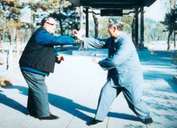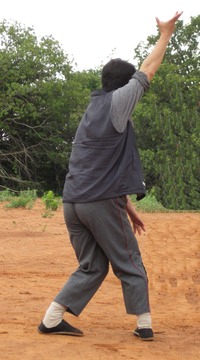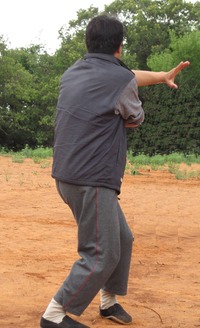2.2 DOUBLE PALM CHANGE
This trains the large koubu and large baibu stepping. It trains the true spirit of the dragon, reaching as high up as possible and as low down as possible, as the dragon soars into the sky and drops into the sea at will. It trains the large koubu and larger baibu steps, liaozhang, rising and dropping, gaizhang, and zhuangzhang. The variations train more rising and falling, and the interchange between hard and soft. All movement is big and comfortable. Practising this change opens up the tendons, bones, qi, and blood.
The movements create a characteristic, they are the means, not the end. The end is to manifest the spirit of the dragon. The movements must be done perfectly in order to draw this out. The dragon feeling is the best for opening up the tendons, and once the tendons are opened up then they can connect. This will automatically open up the qi and blood. Do not separate the internal from the external. The correct movements will correct the qi and blood.
Movement Names: Reach To The Heavens, Draw Up The Cloak While Walking Along, Reach To The Heavens And Stab Into The Ground, Large Koubu Baibu Gaizhang, Zhuangzhang, Gather Up The Enemy On Horseback, Hide A Flower Under A Leaf, Dragon Turns Its Head.
Description: starting in dragon form with the left hand up.
Action One: Koubu the right foot across its walking line, not crossing the left foot, settle into the right leg, and sweep the left hand up. (At first make the biggest circle possible, later on it can become more natural). Sweep the arm in preparation for the following liaozhang, already following that direction, do not just lift it up.
Action Two: Baibu the left foot onto the outside line of the circle, liaozhang with the left hand. Circle the hand down past the right knee before stepping out (settle down into the right leg before stepping into the mabu). Bring the right hand down to protect the groin area, fingers pointing to the left knee. Make this a large, proud movement, like getting your robe out of the way and being impressive about it. The arm doing the liaozhang is on a straight line with the heels of the mabu, to open up the shoulders.
Action Three: Koubu the right foot, rise up and slide the right hand up along the left arm, first with the back on the hand on the arm, then turning and stabbing straight up until the upper arm is at the ear. Slide the left hand down to the shoulder. Then sit down and stab the left hand down beside the leg, placing the back of the hand by the right knee. Be sure to keep the left arm extended and slide the right hand up along it, pulling the left hand in to the armpit, and then stab the left hand down – do not do both moves at once.
Action Four: Extra koubu with the right foot, around and slightly outside the circle, keeping the arms in the same place relative to the body. Baibu the left foot into mabu and open the arms, aligning them with each other. Keep the left hand on the right knee during the extra koubu, then move it to the left knee for the baibu. The back of the left hand is on or beside the kneecap in the mabu. The right arm draws a straight angled line with the lead arm, so is above the head slightly outside the line of the legs, palm up, shoulder open. The power is in the upper back. Settle down so that the power will go out.
Action Five: Large koubu with the right foot all the way around to almost back onto the circle. Gaizhang with the right hand, striking forward into the head. Grab and pull the left hand down to under the elbow, hand either clenched or slightly cupped. Be sure to use both arms together. One variation is to not step around quite so much, but just to the outside.
Action Six: Shift the left foot to get aligned with the circle and into a comfortable mabu. If you stepped less on the gaizhang, step through back to the walking line to the mabu. Bring the left hand in then do a single zhuangzhang to the left side. The hands are in a straight line, the fingers pointing forward or slightly angled. Then stay in mabu and do a single zhuangzhang with the right hand to the right side. Look to the hitting side before the zhuang. Use the hip, body, and shoulders, not the arms.
Action Seven: Right koubu, hide the flower under a leaf.
Action Eight: Dragon turns its head.
Action Nine: Place in dragon form for walking.
Video of Andrea doing the first and second palm changes.
The variations of the change are not in any specific order. They are numbered for convenience and this order may be adjusted later.












